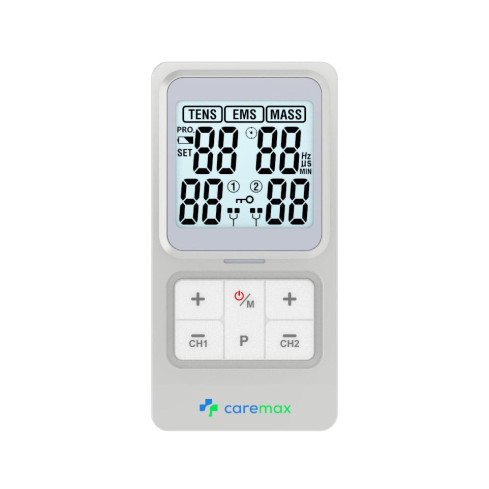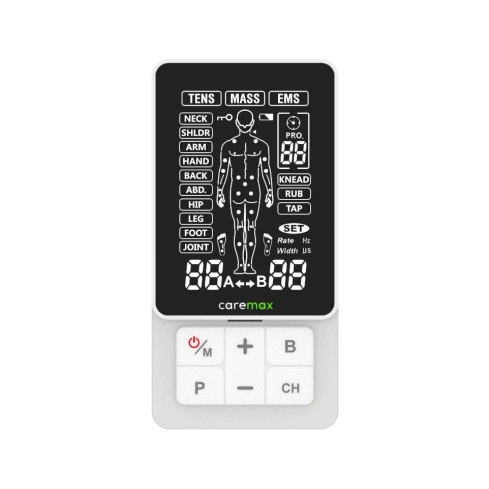Product added to cart
- Home
- TENS & EMS
- Use TENS Machine for Migraine Headache: A Complete Guide
Use TENS Machine for Migraine Headache: A Complete Guide
Transcutaneous Electrical Nerve Stimulation (TENS) can be used as a potential treatment for migraines. It involves applying low-voltage electrical currents through the skin to potentially interfere with pain signals. Although more research is required, TENS is considered part of a comprehensive treatment strategy rather than a standalone solution. It's important to discuss the use of TENS for migraines with a relevant healthcare professional.
What is a headache?
A headache occurs when pain occurs throughout any area of the head. The symptoms of headaches can vary from person to person. According to the International Classification of Headache Disorders, there are more than 200 types of headaches [1].
How a headache feels can differ based on what's causing it. It could be a throbbing sensation, a sharp pain, or just a dull ache. Depending on your circumstances, it might last a short time or drag on for hours or even days. Understanding these differences helps you figure out what kind of headache you've got and how to manage it better.
Type of Headache: Tension Headache and Migraine Headache
While there are over 200 types of headaches, there are more common types called ‘primary headaches.’ Tension-type and migraine headaches are some of the most prevalent primary headaches.
Tension-type headaches are quite common, affecting 30–78% of the population [2]. These headaches can occur intermittently or chronically. Symptoms can include head pain, tenderness around the scalp and/or neck, occuring on both sides, and pressure around the head.
Migraine is a widespread and disabling primary headache disorder. There are two main types, which include migraines with and without an aura [3]. Symptoms of migraine include head pain, sensitivity to light (photophobia), sensitivity to sound (phonophobia), nausea, and vomiting. Those who have migraines with auras will have visual disturbances, such as flashing lights or blind spots [3].
Comparing tension-type headaches with mild migraines is challenging. Research has suggested that tension-type headaches lack non-pain-related symptoms such as light sensitivity or nausea (unlike migraines) [4].
What Causes Migraine Headache?
Migraines are recurring headaches that come with other symptoms like nausea and sensitivity to light and sound. The exact cause isn't fully understood, but it seems to involve a range of different factors, including [5] and [6].
- Having family members with migraines
- Changes to the brain or trigeminal nerve.
- Chemical balance, such as serotonin levels in the brain
- Environmental triggers, such as certain foods, lack of sleep, stress, and environmental factors like bright lights,
- Hormonal changes
- Poor blood flow to the head
- Poor sleep
- Anxiety
- Certain medications
- Hormonal changes
Range of Migraine Headache Symptoms
Symptoms of migraine headaches vary from person-to-person but commonly include [6]:
- Pain around the head occurs without warning.
- Pain that usually occurs on one side of the head
- Confusion
- Blurred vision
- Changes in mood
- Low energy and tiredness
- Sensitivity to light, sound, or noise
Common Treatments for Migraine Headache
Treatment for migraine headaches will depend on your own set of circumstances. It’s important to seek the advice of your GP or relevant healthcare provider to ensure that you’re receiving the necessary treatment. Common treatments include [7]:
- Medications
- Preventative practices (e.g., stress management, exercise, dietary changes, etc.)
- Physiotherapy
- Neuromodulation devices
- Cognitive-behavioural therapy
- Alternative treatments, such as acupuncture and massage,
What is a TENS machine, and how can it help migraine?
A TENS machine, which stands for Transcutaneous Electrical Nerve Stimulation, is a device used for pain management. It's a small, battery-operated device that delivers low-voltage electrical currents to the skin through electrodes. These electrodes are placed around areas of pain to help override pain signals to the brain. Research suggests that these machines can also be used to effectively treat headache conditions, such as migraines [8].
What's the best way to use a TENS machine for migraine?
The TENS machine can be used to help reduce or prevent migraine symptoms. Different settings on the device will allow you to deliver effective treatment [8].
Here are the best practices for using a TENS unit:
There are several factors and settings to consider when using the TENS unit, including location of treatment, pulse rate, pulse width, and intensity.
Electrode Pads for TENS Migraine Treatment
The placement of electrode pads for TENS migraine treatment will vary from person to person. Always consult your GP or healthcare professional before treatment. For safe and effective treatment, we advise placing the electrodes at the base of the neck and upper trapezius muscles. Placing the pads over sensitive areas of the head could lead to unwanted side effects, such as worsening symptoms and seizures. Another potential way of delivering treatment for headaches is via the vagus nerve.
Setting the Pulse Rate (Frequency) for Migraine Treatment
The frequency of migraine treatment can be determined by the symptoms that you’re trying to treat [9]. Those with acute symptoms should opt for a higher-frequency setting (>90 Hz) for immediate pain relief. Those with chronic symptoms who’d prefer to prevent migraine symptoms may consider using a lower frequency setting (~2 Hz).
Setting the Pulse Width for Migraine Treatment
How pulse width impacts treatment has yet to be fully determined. However, studies have used pulse width settings around 200 µs to successfully treat migraine symptoms [10].
How Often or How Long Should You Use Your TENS Machine for Migraine Treatment?
The effective duration of TENS machine treatment for migraines will vary from person to person. To help relieve the symptoms of migraines, research has shown that 30 minutes of treatment can be beneficial [11]. Other researchers have shown that 15-minute treatments for three sessions weekly can also prevent headaches [10].
Using Caremax TENS machine for Migraine Headache Mangement
We provide a comprehensive packaging solution for Migraine Headache Relief. Discover the most sought-after products below essential for effective TENS therapy treatment.
 |
 |
| Caremax 2.0 Classic TENS machine | Caremax 2.0 Pro TENS Machine |
Where and when to not use TENS machines
While the TENS machine is generally considered safe, it is important to exercise caution in specific situations and areas. Avoid using the TENS machine on damaged skin (such as wounds or cuts), areas with altered sensation (like tingling or reduced sensitivity), swollen regions, near cancers or clots, areas exposed to radiotherapy or radiation, and around critical arteries in the neck (particularly the carotid area). Safety regarding the placement of electrodes around the face or head should only be considered when speaking to a qualified health professional [12].
Additionally, individuals in certain conditions, including pregnant women, individuals with implanted devices (such as pacemakers or neurostimulators), those facing cognitive or mental challenges, and those unable to provide consent for treatment, should either refrain from using the TENS unit or consult their GP before doing so [12].
Are there any risks of side effects when using a TENS machine?
Transcutaneous Electrical Nerve Stimulation (TENS) is a widely used method for pain management, employing low-voltage electrical currents delivered through electrodes to alleviate discomfort. While TENS is generally safe, it's crucial to be aware of potential side effects. This overview outlines the common and more severe side effects associated with TENS use, emphasising the importance of proper application and prompt medical attention if adverse reactions occur. If any side effects are noticed, it is essential to discontinue the treatment. Side effects include [12]:
Typically reported side effects:
- Skin irritation
- Unusual sensations around the treatment area
More Uncommon Side Effects:
- This occurs when the TENS unit is used inappropriately or in unsafe areas.
- Unsuitable candidates may experience more severe side effects.
- Rashes
- Increased pain
- Seizures
- Disruptions to implanted medical devices
- Strokes
- Blood clots
- Skin damage
- Burns
References
- International Headache Society. (n.d.). International Classification of Headache Disorders (ICHD-3). Retrieved from https://ichd-3.org/
- International Headache Society. (n.d.). Tension-type headache. Retrieved from https://ichd-3.org/2-tension-type-headache/
- International Headache Society. (n.d.). Migraine. Retrieved from https://ichd-3.org/1-migraine/
- Puledda, F., & Goadsby, P. J. (2023). An update on non-invasive neuromodulation for the acute and preventive treatment of migraine. The Journal of Headache and Pain, 24(1), 9. https://doi.org/10.1186/s10194-023-01614-0
- National Center for Biotechnology Information. (n.d.). Migraine. In StatPearls. Retrieved from https://www.ncbi.nlm.nih.gov/books/NBK560787/
- National Institute of Neurological Disorders and Stroke (NINDS). (n.d.). Migraine Information Page. Retrieved from https://www.ninds.nih.gov/health-information/disorders/migraine
- RACGP. (2021). The state of migraine. Australian Journal of General Practice, 50(12), 865-869. Retrieved from https://www1.racgp.org.au/ajgp/2021/december/the-state-of-migrain
- Raffaelli, B., & Reuter, U. (2018). The biology of a migraine attack—lessons from genetic, imaging and blood-based biomarkers. The Journal of Headache and Pain, 19(1), 6. https://doi.org/10.1186/s10194-018-0868-9
- Zhang, Y., Liu, J., Li, H., Yang, J., Li, X., Li, Y., ... & Chen, N. (2012). Meta-analysis of acupuncture therapy for the treatment of stable angina pectoris. Journal of Alternative and Complementary Medicine, 18(6), 1-7. https://www.ncbi.nlm.nih.gov/pmc/articles/PMC3263106/
- Ma, L., Yue, L., & Zhang, Y. (2017). Efficacy and safety of transcutaneous occipital nerve stimulation for migraines: A meta-analysis. Cephalalgia, 37(6), 607-615.
- University of Iowa Hospitals & Clinics. (2018). Contraindications, precautions, and best practices for TENS. Retrieved from https://www.healthcare.uiowa.edu/marcom/uihc/pain_medicine/contraindication_precautions_best062018.pdf
Categories
- TENS & EMS (19)
- Latest News (41)
- Massager (2)
- Nebuliser (8)
- Skin Care (3)
- Period Pain Management (1)
- Fitness (2)
